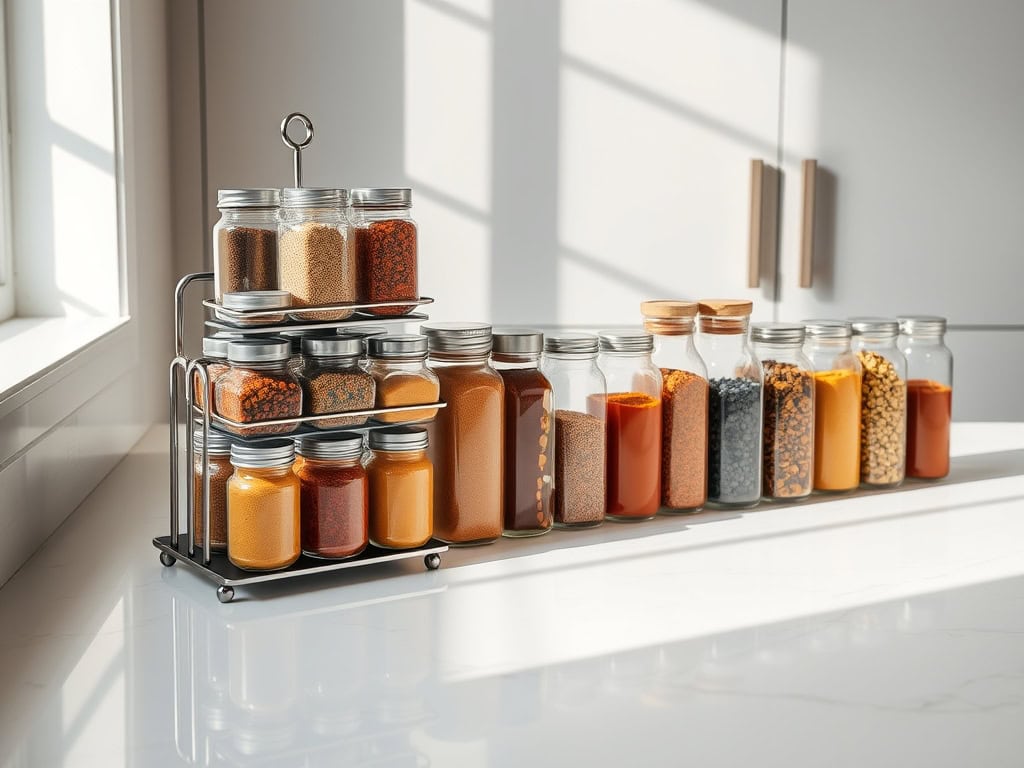Is your spice collection taking over your kitchen counters and cabinets? You’re not alone! As someone who once had tumbling towers of seasonings, I’ve discovered game-changing ways to tame the chaos. From magnetic racks that transform blank walls into storage gold to clever drawer systems that’ll make you wonder why you didn’t organize sooner, these eight ingenious solutions will revolutionize your cooking space. Let’s explore how you can turn your cluttered spice situation into an organized chef’s paradise.
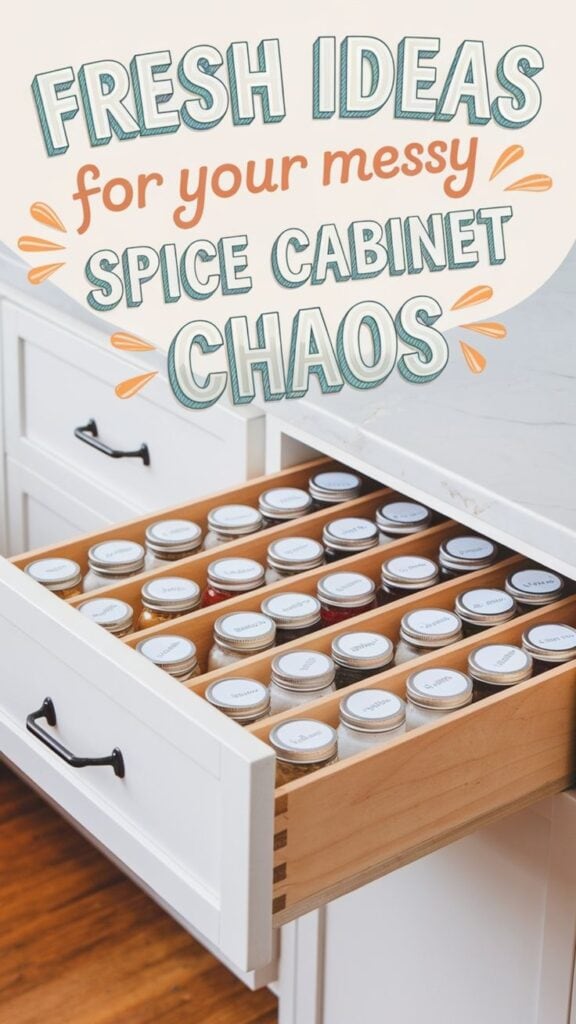
Magnetic Spice Racks: Space-Saving Wall Solutions
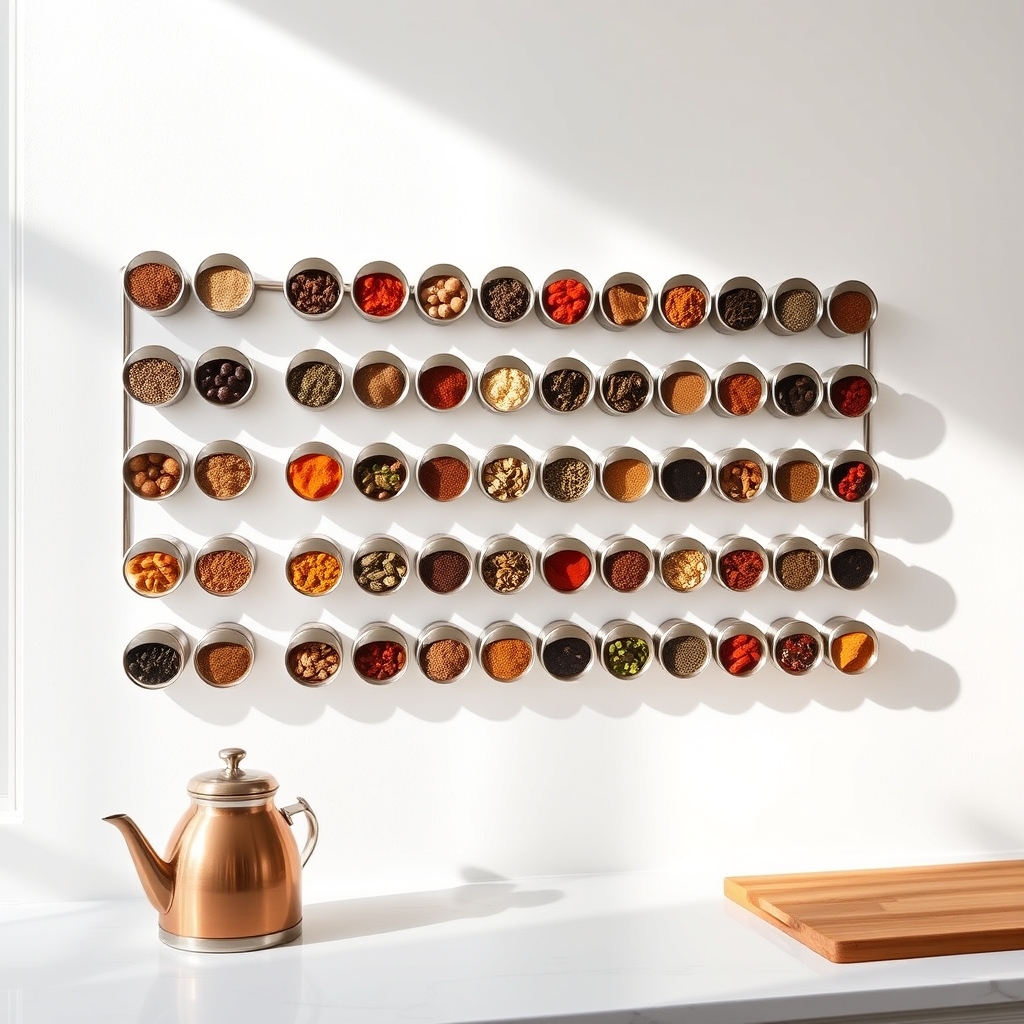
A well-organized magnetic spice rack system transforms an ordinary kitchen wall into a functional storage space while keeping frequently used seasonings within arm’s reach. By utilizing vertical wall space, this modern solution eliminates the need to dig through crowded cabinets or drawers, making cooking more efficient and enjoyable.
Magnetic spice organization not only saves valuable counter and cabinet space but also creates an attractive visual display that can enhance your kitchen’s aesthetic appeal. The ability to see all your spices at once helps prevent duplicate purchases and ensures you’re using seasonings before they lose their potency.
Required Items:
- Magnetic spice containers with clear lids
- Magnetic strips or boards
- Label maker or waterproof labels
- Measuring funnel
- Clean cloth
- Level
- Drill and screws
- Wall anchors
- Permanent marker
Mount the magnetic strip or board on your chosen wall space, ensuring it’s level and properly secured with appropriate wall anchors. Transfer spices from their original containers into the magnetic ones, using a funnel to prevent spillage. Create clear, legible labels for each container, including both the spice name and purchase date.
Arrange the containers on the magnetic surface in a logical order – whether alphabetically, by frequency of use, or by cuisine type. Consider the wall location carefully, avoiding areas directly above the stove where heat and steam could affect the spices’ freshness. Position frequently used spices at eye level for easy access, and group similar items together. For example, keep baking spices in one section and savory seasonings in another.
Test the magnetic hold strength of each container before fully releasing it onto the strip.
Additional Tips: Rotate your spice collection every six months, bringing less-used items to the front and checking expiration dates. Keep a few empty magnetic containers on hand for new spice purchases or blends. Clean the containers and magnetic surface monthly with a dry cloth to prevent buildup, and store overflow supplies in a cool, dark place until needed.
Clear Container Systems for Visual Organization
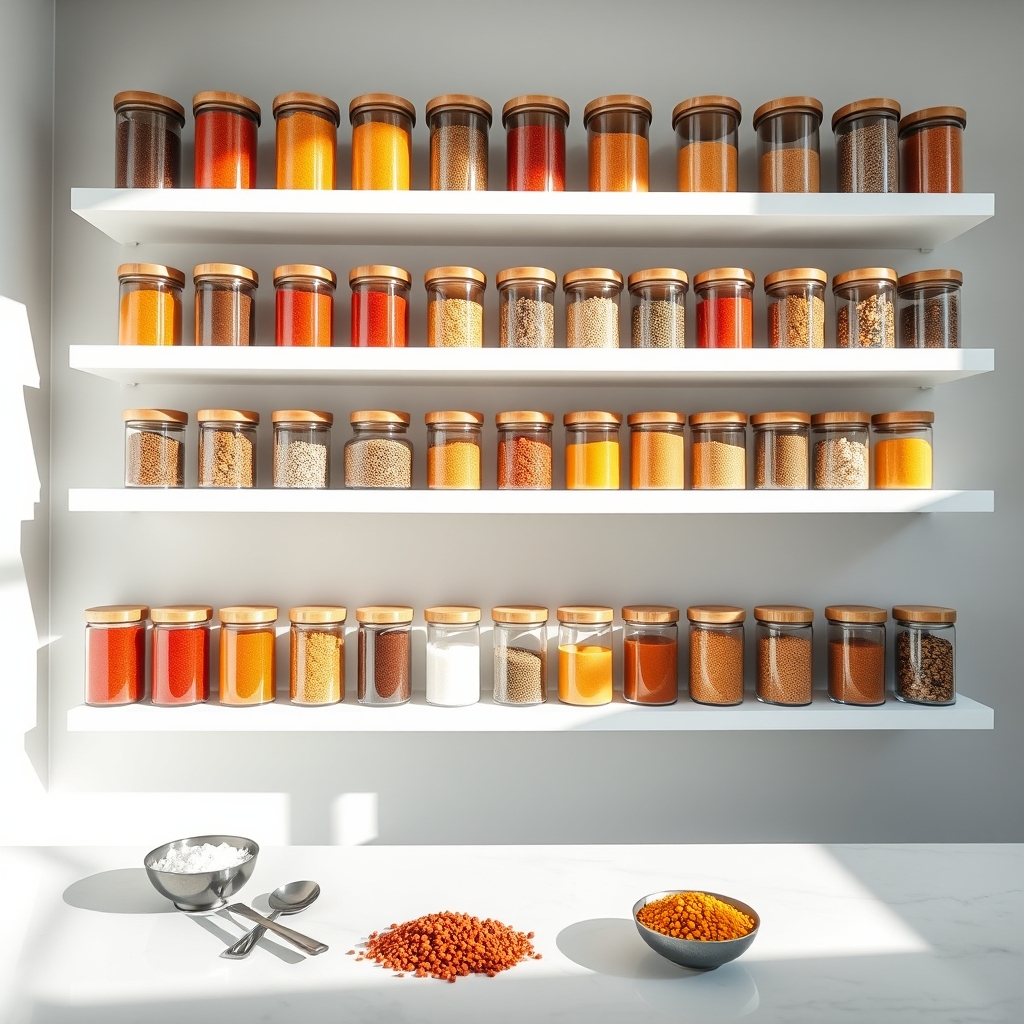
A well-organized spice and seasoning collection is fundamental to an efficient kitchen workflow. When seasonings are stored in clear containers, you can instantly identify ingredients, monitor inventory levels, and maintain freshness without rifling through a jumbled cabinet of mismatched containers.
Visual organization through clear containers not only streamlines cooking but also transforms your kitchen into a more professional and aesthetically pleasing space. This system eliminates the frustration of searching for specific spices during meal preparation and ensures that you’re using the freshest ingredients possible.
Required Items:
- Clear glass or plastic storage containers
- Labels and marker
- Measuring funnel
- Clean cloth or paper towels
- Airtight lids
- Label maker (optional)
- Shelf liner
- Container size variety pack
- Small scoop or spoon set
Select uniform containers with airtight seals and transfer seasonings from original packaging. Clean each container thoroughly and ensure it’s completely dry before adding spices. Use a funnel to prevent waste during transfer, and immediately label each container with the spice name and date of packaging.
Arrange containers by frequency of use or alphabetically, depending on your cooking style. Create designated zones within your storage area based on cooking categories – baking spices, everyday seasonings, and specialty blends. Position frequently used items at eye level and ensure all labels face forward for easy reading.
For optimal freshness, store containers away from direct sunlight and heat sources.
Additional Tips: Consider implementing a rotation system where newer spices are placed at the back while older ones move forward. Maintain an inventory list on your phone or inside the cabinet door to track when to replace seasonings. Clean containers monthly with a dry cloth to prevent residue buildup and regularly check seals to ensure continued freshness.
If possible, store ground spices and whole spices separately as they’ve different shelf lives.
Drawer Insert Solutions for Easy Access
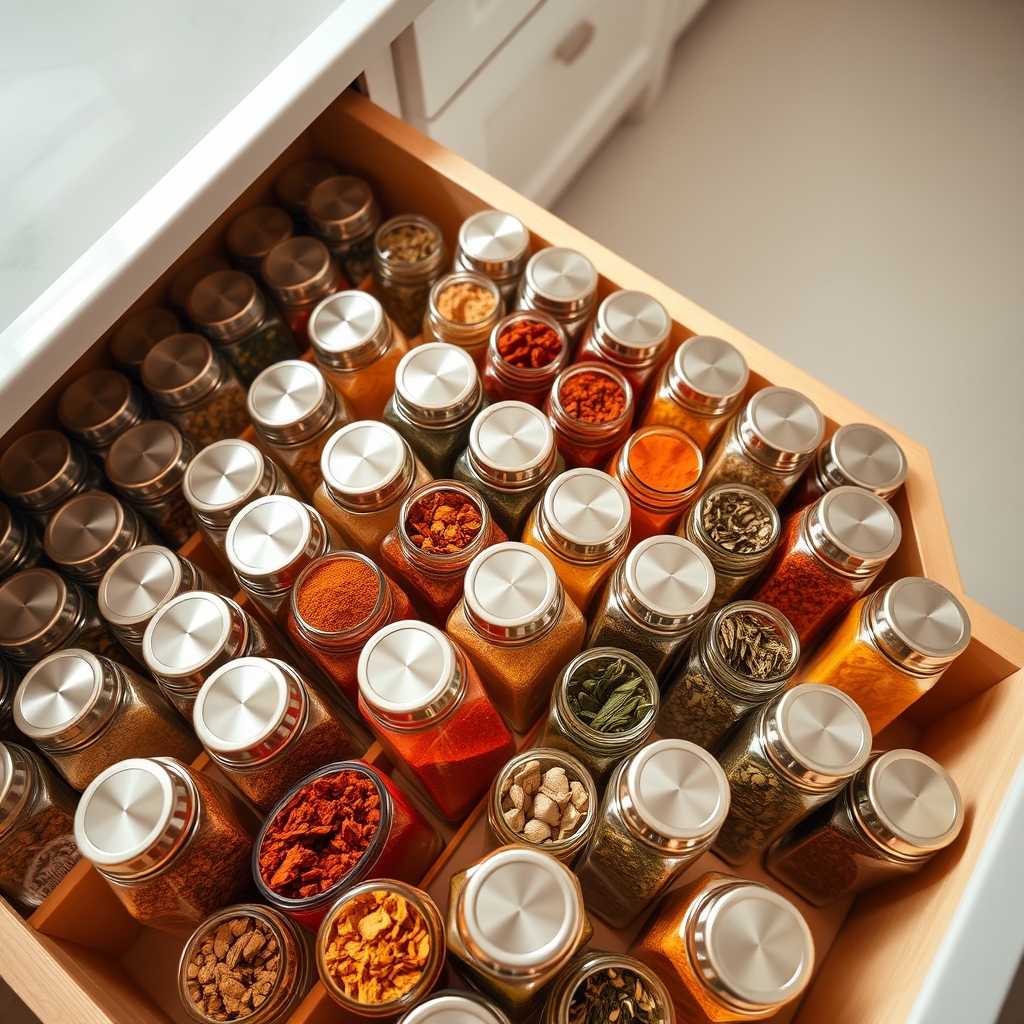
A well-organized spice drawer can transform daily cooking from a chaotic search for seasonings into a smooth, efficient process. When spices and seasonings are properly arranged in drawer inserts, they become instantly visible and accessible, eliminating the frustration of rummaging through cluttered cabinets or spinning lazy Susans.
Drawer organization systems specifically designed for spices not only maximize storage space but also protect valuable seasonings from light exposure and heat fluctuations that can occur in above-counter storage solutions. This method keeps spices fresher longer while maintaining an orderly kitchen workspace that encourages more frequent and enjoyable cooking experiences.
Required Items:
- Drawer insert or spice organizer
- Measuring tape
- Labels or label maker
- Container uniformity assessment tool
- Drawer liner material
- Small containers or jars (if transferring spices)
- Cleaning supplies
- Drawer dividers (adjustable)
- Rubber grip liner
Start by measuring your drawer dimensions carefully, accounting for both the width and depth, as well as the height clearance when closed. Remove everything from the drawer and thoroughly clean it.
Install a non-slip drawer liner to prevent containers from sliding around when opening and closing the drawer.
Select an insert system that maximizes your drawer space while accommodating your existing spice containers or transfer spices to uniform containers that fit your chosen organization system. Arrange spices alphabetically or by frequency of use, with the most-used items positioned toward the front of the drawer.
For tiered inserts, place taller containers in the back rows and shorter ones in front for optimal visibility.
Consider grouping seasonings by category (baking spices, ethnic cuisines, or salt varieties) within designated sections of your drawer insert. This creates intuitive zones that make locating specific items faster and more efficient.
Label each container’s lid for easy identification when looking down into the drawer.
Additional Tip: Review your spice collection every six months, replacing outdated items and adjusting the organization system based on your cooking habits.
Consider keeping a master list of your spice inventory taped inside the cabinet door above the drawer for quick reference when meal planning or grocery shopping.
Rotating Carousel Storage for Counter Convenience
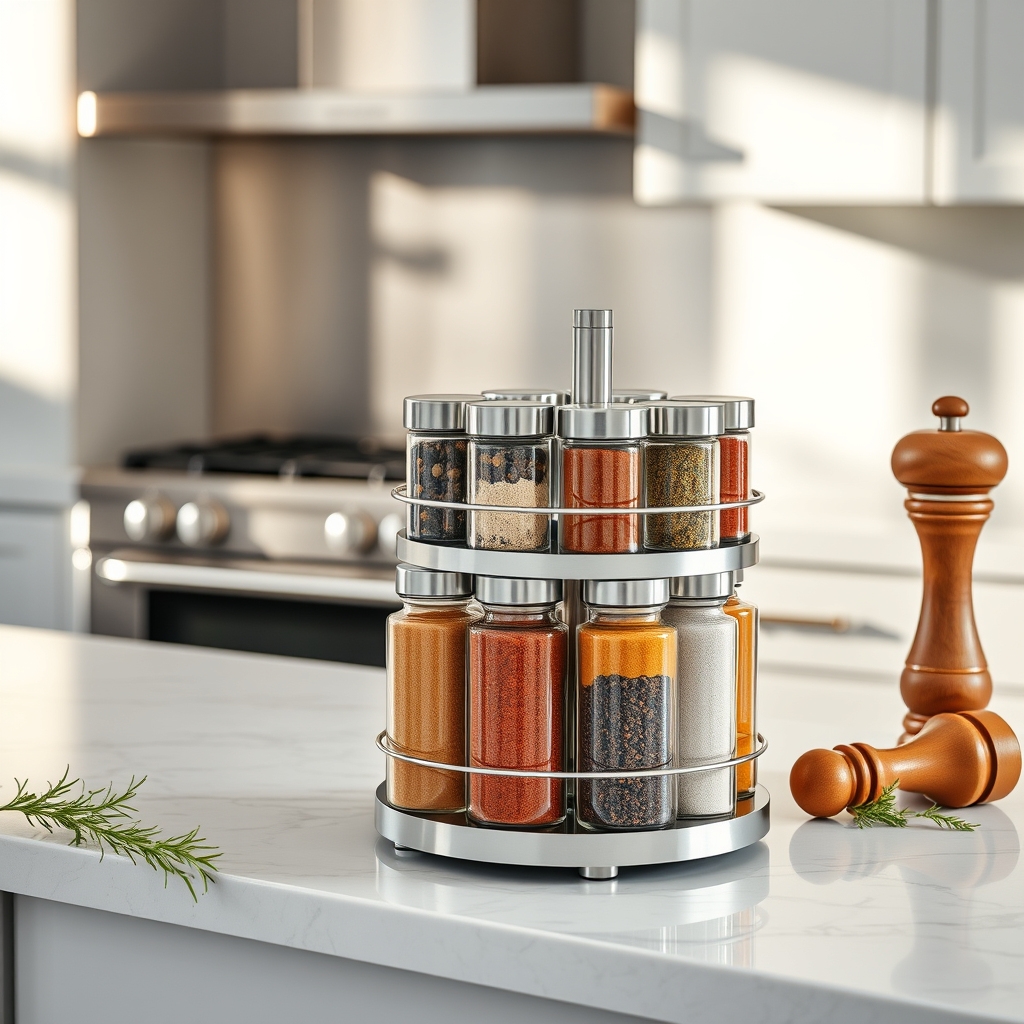
A well-organized rotating carousel for seasonings transforms daily cooking from a frustrating search for spices into a smooth, efficient process. When frequently used seasonings are readily accessible and visible, meal preparation becomes more enjoyable and time-efficient, allowing home cooks to focus on the creative aspects of cooking rather than hunting for ingredients.
The rotating carousel system serves as both a practical storage solution and an attractive countertop display. By keeping essential spices within arm’s reach while cooking, this organization method reduces kitchen clutter and eliminates the need to constantly reach into cabinets or dig through drawers, making it particularly valuable for those who cook regularly or have limited kitchen space.
Required Items:
- Two-tier rotating carousel organizer
- Clear spice jars with labels
- Label maker or waterproof labels
- Measuring funnel
- Small scoop or spoon
- Cleaning cloth
- Container for excess spices
- Storage basket for backup spices
The organization process starts with a thorough assessment of frequently used seasonings. Place the carousel in a convenient spot near the cooking area, ensuring it’s away from direct heat and sunlight. Transfer spices into matching clear containers, using the funnel to prevent waste.
Arrange the most-used items on the lower tier for easy access, with secondary spices on the upper level. Group similar items together – for example, keep baking spices in one section and savory seasonings in another.
The system works best when maintained regularly. Establish a routine of checking spice levels weekly and refilling from backup supplies as needed. Keep the carousel clean by wiping it down monthly with a slightly damp cloth to prevent spice dust accumulation.
Consider implementing a color-coding system for different categories of spices to enhance visual organization.
Additional Success Tips: Position the carousel slightly away from walls to ensure smooth rotation, and maintain an inventory list of backup spices stored elsewhere. Replace spices annually to ensure maximum flavor, and adjust the organization system seasonally based on cooking patterns.
Consider adding small silica gel packets to each tier to prevent moisture buildup and maintain spice freshness in humid environments.
Door-Mounted Organizers: Making Use of Hidden Space
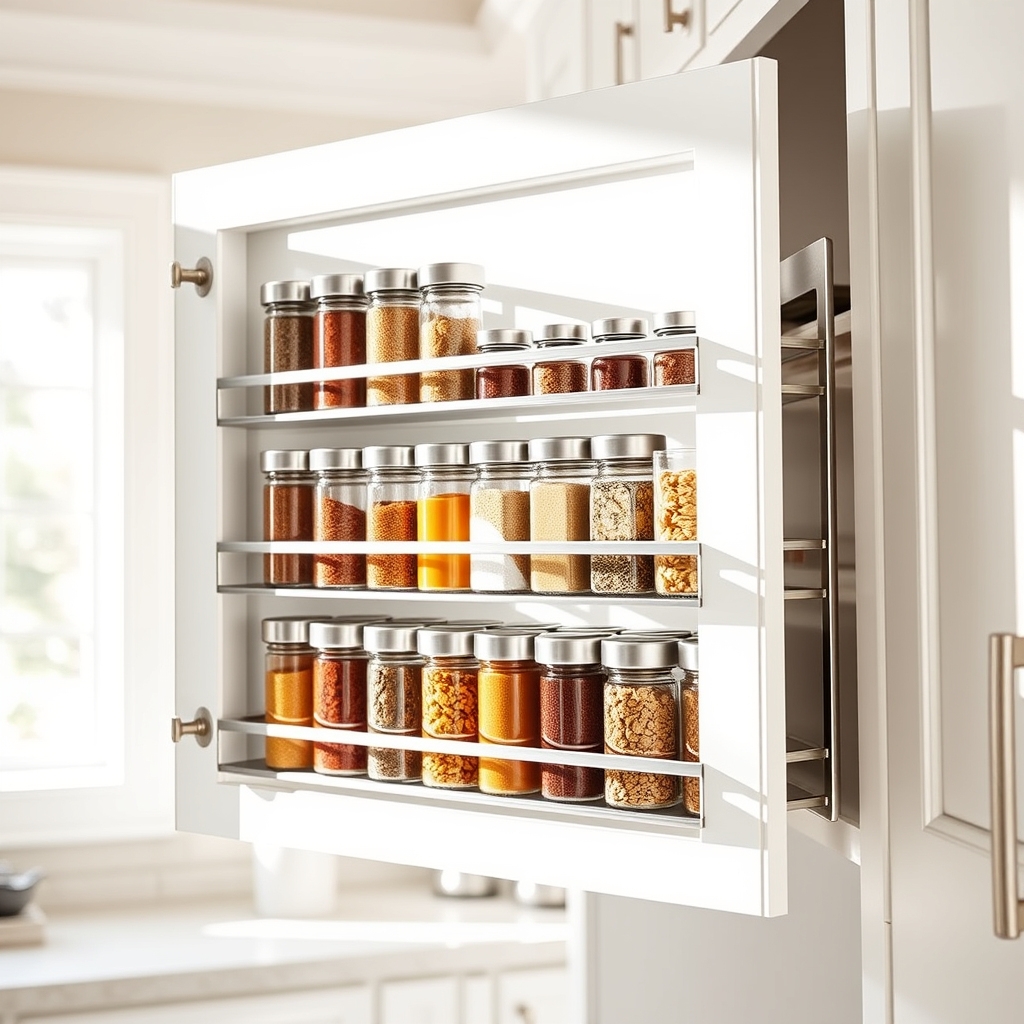
Making efficient use of cabinet door space is a game-changer for kitchen organization, particularly in smaller kitchens where counter and shelf space is limited. Door-mounted organizers transform previously unused areas into valuable storage real estate, keeping frequently used seasonings within easy reach while freeing up precious cabinet and counter space.
Door-mounted storage solutions are especially effective for spice organization because they allow for clear visibility of all containers at once, eliminating the need to shuffle through stacked bottles or reach into deep cabinets. This system also helps maintain freshness by keeping spices away from direct sunlight and heat sources while remaining easily accessible during food preparation.
Required Items:
- Over-the-door spice rack or organizer
- Mounting hardware (screws, brackets)
- Measuring tape
- Pencil
- Screwdriver
- Level
- Command strips (optional)
- Clear spice containers (optional)
- Labels
- Shelf liner (optional)
Installation and organization begins with measuring the interior cabinet door and selecting an appropriately sized organizer. Position the rack to ensure adequate clearance when closing the door, marking mounting points with a pencil. Install the organizer according to manufacturer instructions, using proper hardware or Command strips for non-permanent installation.
Sort spices by frequency of use, placing everyday seasonings at eye level. Consider transferring spices to uniform containers for a cohesive look and better fit, labeling each clearly on the top and side for easy identification from multiple angles.
For optimal success, consider implementing a rotation system where newer spices are placed at the back of each shelf while older ones move forward. Line the shelves with non-slip material to prevent containers from shifting when opening and closing the door. Regularly audit the contents to ensure all spices remain fresh and frequently used, removing rarely used items to maintain an efficient system.
Custom Label Systems for Quick Identification
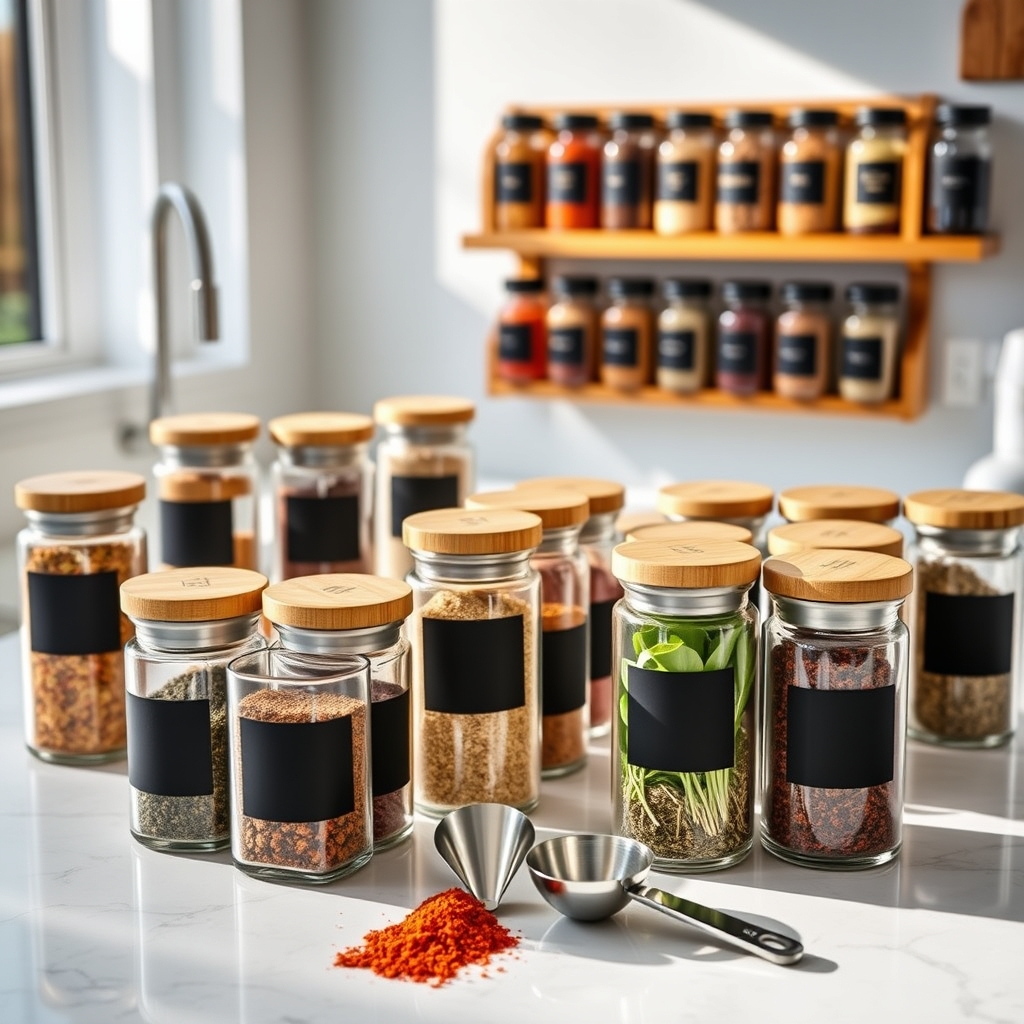
An organized spice and seasoning collection is essential for efficient cooking and meal preparation. When containers are clearly labeled, you can quickly grab exactly what you need without wasting time searching through similar-looking jars or accidentally using the wrong ingredient.
Creating a custom label system transforms a cluttered spice cabinet into a functional cooking station. Well-designed labels not only make ingredients instantly identifiable but also add a professional, cohesive look to your kitchen while protecting containers from mix-ups during refills or transfers.
Required Items:
- Label maker or waterproof labels
- Clear containers or spice jars
- Waterproof marker
- Measuring spoons
- Funnel
- Cleaning cloth
- Clear protective tape (optional)
- Category dividers (optional)
- Label template software (optional)
Start by removing all seasonings from their current storage space and cleaning each container thoroughly. Create a standardized labeling format that includes the spice name, purchase date, and optional details like common uses or expiration dates.
When designing labels, choose a font size that’s easily readable from your typical cooking position, and consider using different colors or symbols for various categories (herbs, spices, blends).
For maximum effectiveness, place labels in consistent positions on all containers – typically on the lid and side of each jar. If using transparent containers, ensure side labels don’t block visibility of the contents.
When printing or writing labels, use waterproof materials to prevent smudging from cooking steam or handling. Consider adding extra information like measurement conversions or common recipe amounts for frequently used seasonings.
To maintain your labeling system, establish a routine for updating labels when refilling containers or adding new items. Store backup labels in a designated place, and consider creating a master inventory list with reorder dates.
Using clear protective tape over paper labels will extend their lifespan and protect against kitchen moisture and handling wear.
Tiered Shelf Risers for Cabinet Optimization
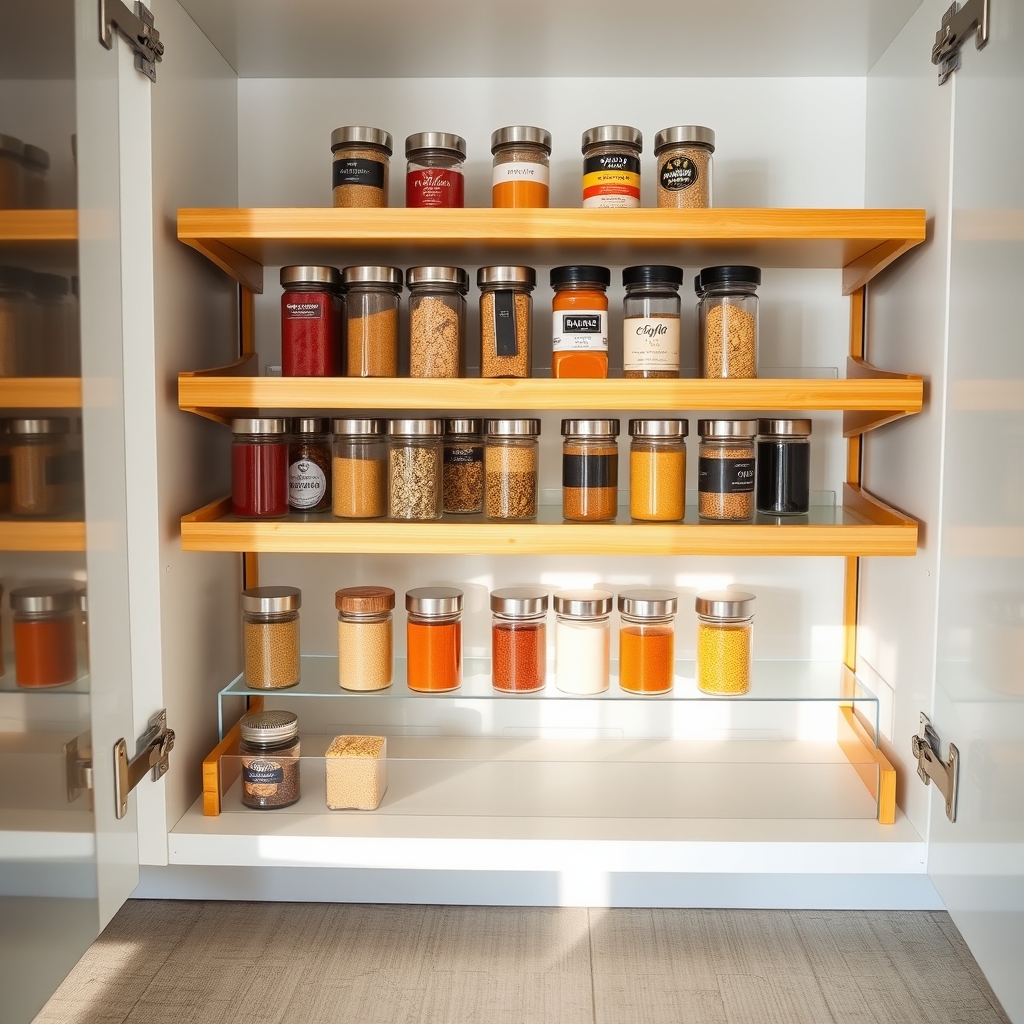
Organizing spices and seasonings in kitchen cabinets can be a constant challenge, with small containers getting lost in deep spaces and frequently used items becoming difficult to locate. A disorganized spice cabinet not only wastes valuable time during meal preparation but can also lead to unnecessary duplicate purchases and expired seasonings.
Tiered shelf risers transform cluttered cabinet spaces into efficient, easily accessible storage systems. These stepped organizers maximize vertical space while ensuring every seasoning container remains visible and within reach, turning a formerly frustrating storage situation into a practical and aesthetically pleasing solution.
Required Items:
- Tiered shelf risers (expandable or fixed)
- Measuring tape
- Cabinet liner (non-slip)
- Label maker or labels
- Cleaning supplies
- Container for duplicate or expired items
- Storage bins (optional)
- Lazy Susan (optional)
Select appropriate tiered shelf risers by measuring your cabinet’s dimensions, ensuring proper depth and width for your specific space. Remove all items from the cabinet and clean thoroughly.
Place non-slip liner on the cabinet base and position the tiered risers, leaving enough clearance for cabinet doors to close properly. Arrange spice containers by frequency of use, placing everyday items on the front rows and occasional-use items toward the back.
Group similar seasonings together, such as baking spices, ethnic seasonings, or salt varieties. Position taller containers on the back tiers and shorter ones in front for optimal visibility.
For optimal organization maintenance, implement a regular rotation system where newly purchased items are placed behind older ones of the same type. Consider alphabetizing within categories or using color-coding for quick identification.
If cabinet space allows, incorporate small storage bins or a lazy Susan for oddly shaped containers that don’t fit well on the risers. Label the edges of shelves with category names to maintain the system’s integrity when replacing items after use.
Pull-Out Cabinet Organizers for Deep Storage
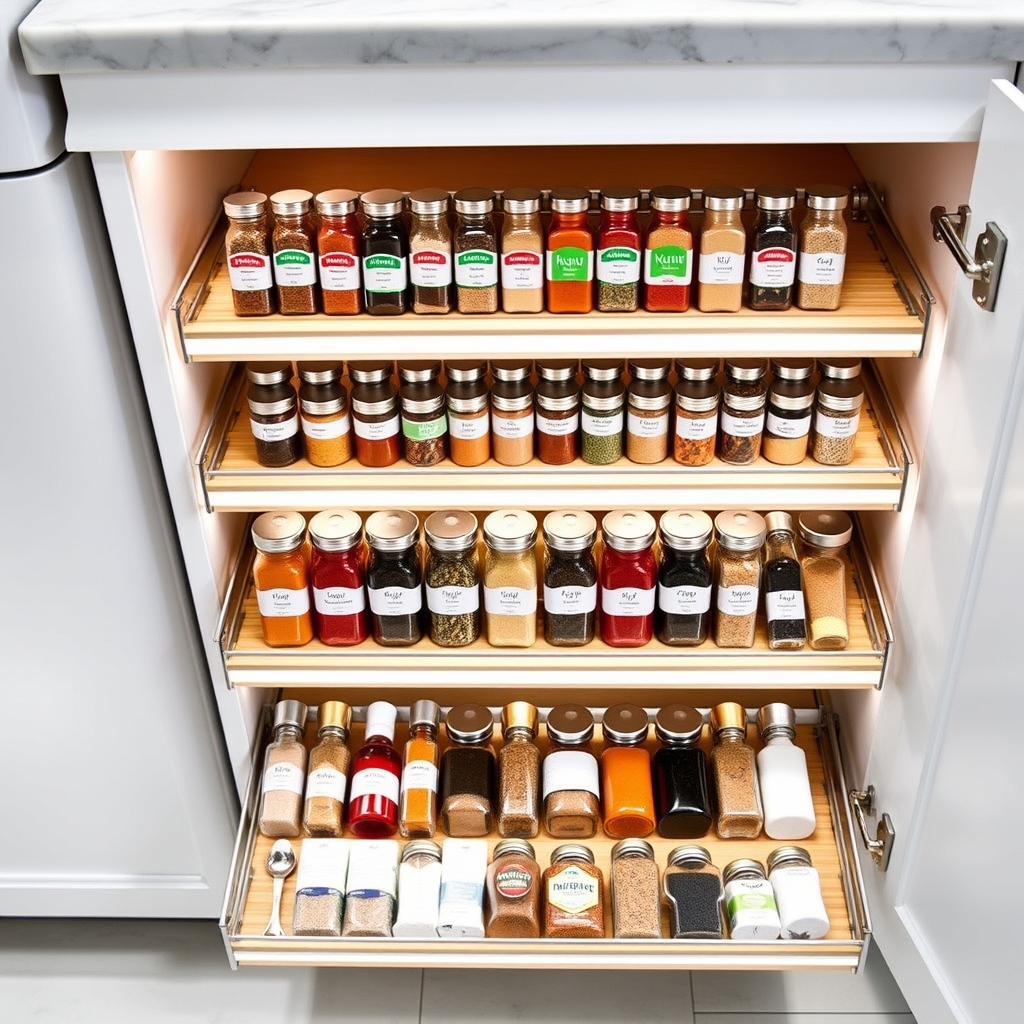
Deep cabinet storage often becomes a black hole of forgotten spices and seasonings, leading to duplicate purchases and expired products. Properly organized pull-out cabinet organizers can transform these challenging spaces into efficient, accessible storage solutions that make cooking more enjoyable and streamlined.
Installing pull-out organizers in deep cabinets allows you to utilize the full depth of your storage space while maintaining easy access to all your seasonings. This system eliminates the need to remove multiple items to reach those in the back and creates a clear visual inventory of your spice collection.
Required Items:
- Pull-out cabinet organizer rails
- Mounting hardware
- Measuring tape
- Screwdriver
- Level
- Cabinet liner (non-slip)
- Spice containers (uniform size preferred)
- Labels
- Storage bins or baskets
- Drawer dividers
Start by removing everything from the cabinet and measuring the interior dimensions carefully. Install the pull-out rails according to manufacturer specifications, ensuring they’re level and properly secured. Place non-slip liner on each shelf level to prevent containers from sliding.
Sort seasonings by frequency of use, placing everyday items at eye level and specialty items on lower shelves. Group similar items together – cooking spices, baking spices, salt varieties, and specialty blends. Arrange containers in rows with labels facing forward, keeping taller items toward the back to maintain visibility.
If using multiple pull-out levels, consider dedicating each level to specific categories. For optimal organization maintenance, conduct monthly reviews of your seasoning inventory, checking expiration dates and replacing items as needed.
Consider installing small LED strips along the rails for better visibility, and keep a master list of your seasonings taped inside the cabinet door for quick reference. Implementing a “one in, one out” rule will help maintain the system and prevent overcrowding.

